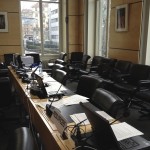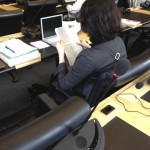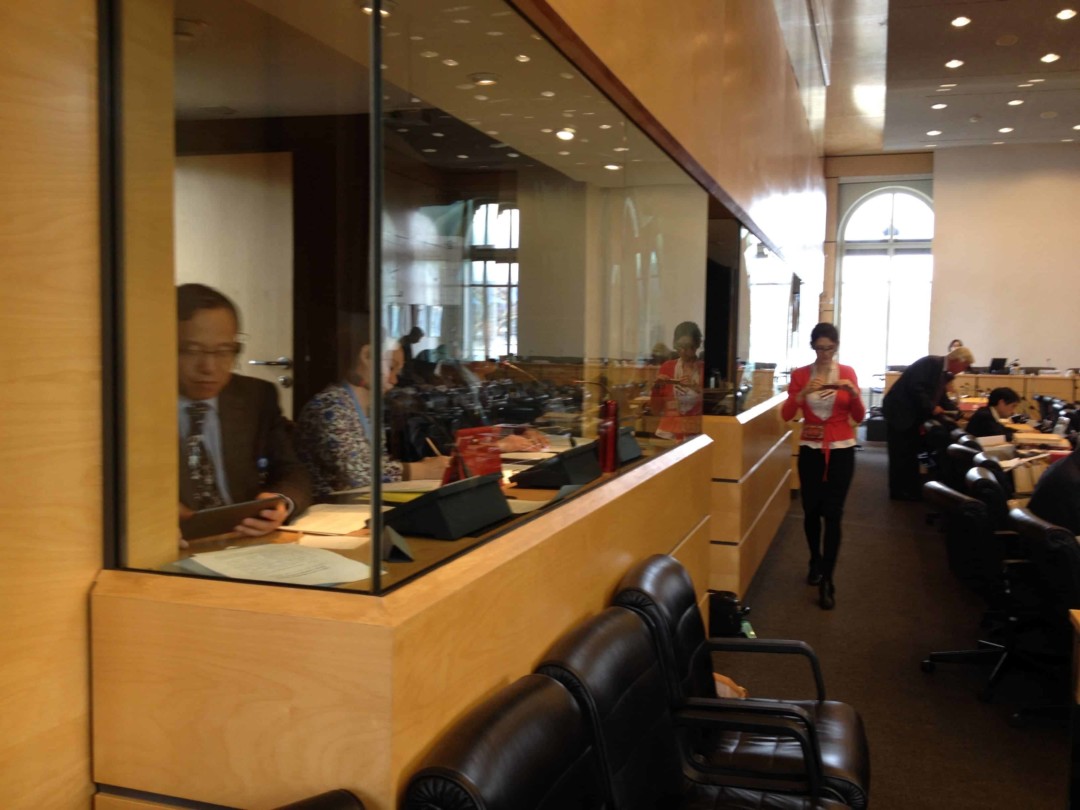In UN treaty body proceedings members of the bodies regularly mention – after they are done with elaborate rounds of welcomes, thank yous and appreciations toward the state presenting its periodic report – that whereas they have been happy to receive statistical information and specific figures in the report they ultimately wish to achieve something more: to be exposed to ‘real reality’.
This plea, articulated in diverse forms, appears in fact so systematic, and yet it forms such a dramatic contrast with what treaty body proceedings could be considered to actually encapsulate that with the present field notes I attempt to recover all of the minuscule details through which ‘real reality’ is transformed into ‘UN reality’.
The Human Rights Committee convenes in the surprisingly small conference room located on the first floor of the Palais Wilson, the original headquarters of the League of Nations prior to the construction of the much larger premises of the Palais du Nations located further up the hill. Today, in addition to treaty body sessions and other conferences, the beautifully renovated Palais functions as the headquarters of the Office of the UN High Commissioner for Human Rights. The conference room entails the usual features of any UN gathering: a podium, a round seating arrangement for the experts who are the main protagonists of the sessions, additional seats at the centre of the room for state delegations, rows for the audience at the back all equipped with headphones and microphones along with wonderfully comfortable lush leather armchairs with the UN press secretaries and members of the UN Congress services located at the back, and finally the booths of the interpreters on two levels. Opposite to the interpreters is a large filing cabinet as visible embodiment of the enormous quantities of documents that used to accompany the Committee’s sessions; the futileness of this once essential construction is concrete embodiment of the fact that slowly but surely also the UN is moving toward a paperless working environment.
During the sessions only people belonging to three categories have the possibility to make oral statements: members of the Committee, state delegations or members of the UN Secretariat – with the obvious exception being formed by UN translators attending to simultaneous translations. Although the purpose of the last group is to merely convey what the speakers of the three previous categories is communicated ‘as is’, without any personal additions, it could be easy to dismiss this category of a ‘voice’; yet relevant things of course always occur in translation and thus their contribution is a very relevant to the unfolding of the sessions. The other category whose voice is struggling to come through is formed by the representatives of NGOs who are not entitled to speak in the official program, but who are today given both a slot – closed from ‘the public’ – in the official program to address the members of the Committee prior to the presentations of states, as well as a – closed – slot in the informal program for lunch hour meetings with the same purpose.
 That ‘real reality’ is far away during the sessions of the Human Rights Committee is communicated by the organizing of the sessions as a whole: true to their quality as international conferences, the sessions of the Human Rights Committee consist of a series of highly formalized and carefully choreographed sessions which last a pre-determined length. Although the sessions are ‘public’ by their definition, this does not mean that just anyone could walk in from the street on a whim: all those present are required to have badges issued on the basis of pre-approved forms. In principle a badge will be issued also to interested outside observers such as scholars; in practice certain ‘delicacies’ apply. I will discuss them in more detail later. To enter into the session a person is also required to enter through security and be accompanied by an identification document, commonly a passport.
That ‘real reality’ is far away during the sessions of the Human Rights Committee is communicated by the organizing of the sessions as a whole: true to their quality as international conferences, the sessions of the Human Rights Committee consist of a series of highly formalized and carefully choreographed sessions which last a pre-determined length. Although the sessions are ‘public’ by their definition, this does not mean that just anyone could walk in from the street on a whim: all those present are required to have badges issued on the basis of pre-approved forms. In principle a badge will be issued also to interested outside observers such as scholars; in practice certain ‘delicacies’ apply. I will discuss them in more detail later. To enter into the session a person is also required to enter through security and be accompanied by an identification document, commonly a passport.
When one participates in the proceedings as an observer, one sits at the back of the room, listening to the proceedings via headphones. Attempting anything different results in is a truly surreal experience: without headphones one hears only the most silent uttering of words from someone speaking at the front of the room whose face one will likely not see. One cannot identify facial expressions or gestures, neither hear any differences in the tone of voice used. Also the name of the person speaking, particularly if the person belongs to a state delegation, will be unavailable as it is usually mentioned in passing with general introductions. In every sense of the word the presentation of states become anonymous presentations of the state, totally depersonalised. The sound space is occupied by vague echoes of sounds coming from infinite headphones, either reproducing the original speech of the person talking, or then one of the numerous simultaneous translations that the interpreters offer non-stop while sitting in the glass-booths located on the side. Present is also rhythmic clacking of keyboards as audience members – those not lulling in their seats, inspecting their phones or checking their Facebook statuses – proceed to record the sessions.
 The outside world is blocked out, distant, and seemingly non-existent, a sensation intensified by the screens that on occasion emerge to block the sun sneaking into the venue through the windows located in its three different corners. Suddenly a motor-bike races outside, or perhaps children shout in the school yard located next to the Palais; otherwise all signs of the ‘real reality’ outside the windows is erased. The ‘UN reality’ inside is finalized by the lulling sound of the air conditioning system, which completes the strange, detached sentiment of the proceedings.
The outside world is blocked out, distant, and seemingly non-existent, a sensation intensified by the screens that on occasion emerge to block the sun sneaking into the venue through the windows located in its three different corners. Suddenly a motor-bike races outside, or perhaps children shout in the school yard located next to the Palais; otherwise all signs of the ‘real reality’ outside the windows is erased. The ‘UN reality’ inside is finalized by the lulling sound of the air conditioning system, which completes the strange, detached sentiment of the proceedings.
As a new session of the Committee begins, for the first few days it is marked by a sense of enthusiasm and concentration: people arrive to the sessions punctually, very few people leave the conference room while the sessions are still running for impromptu coffee breaks or personal chats, and most of the audience maintains their focus on the events at hand with only the occasional representative of the UN secretariat touring the room to check up on practical matters; whether the microphones of the interpreters are working, or the schedules of informal NGO meetings are still current. During these days expressions in the seminar room are sombre and attentive with every participatory detail highlighting the importance of the ceremony we are all jointly bringing to life. For these fleeting few days it becomes possible to see, meet the archetype of ‘the international human rights community’ in reality: a group of concerned world citizens who have travelled great geographic distances to participate in a ceremony to improve the world.
 By day three this archetype starts to become fader as the community becomes increasingly transformed into that ‘real people’: people for whom it, alike all other people, simply remains impossible to remain solely focused on the intricacies of the ceremony at hand, and who seek retreat to their ‘real reality’ outside via modern technologies – replying to new emails, checking newspaper websites for updates on world events, updating their Facebook statuses. Some also use this rare opportunity to sit still to continue work on outstanding publishing commitments, editing texts and drafting new ones. Even fewer still relish the rare opportunity for a rest, even a nap.
By day three this archetype starts to become fader as the community becomes increasingly transformed into that ‘real people’: people for whom it, alike all other people, simply remains impossible to remain solely focused on the intricacies of the ceremony at hand, and who seek retreat to their ‘real reality’ outside via modern technologies – replying to new emails, checking newspaper websites for updates on world events, updating their Facebook statuses. Some also use this rare opportunity to sit still to continue work on outstanding publishing commitments, editing texts and drafting new ones. Even fewer still relish the rare opportunity for a rest, even a nap.
As the session continues in the following weeks, it slowly becomes characterized by a more relaxed atmosphere. Since the number of participants for the Committee’s sessions is relatively small – the lowest number of people I counted as being in the room at one time was under fourty – security guards at the gate recognize most regular participants, and sometimes ease on the formalities of presenting a badge or passport, perhaps even welcoming the observer to proceed straight through the metal detector. By week two people start sneaking into the conference room late, one can catch recently acquainted audience members exchanging their experiences from the previous night in Geneva, with the occasional Committee member sneaking in the formally forbidden snack or Coke. At the podium the liturgy continues as state delegations change: the endless litany of legislative reforms, policy initiatives, committees, communications, plans, follow-ups – all continuing their work to construct the seamless tale of progress, only shortly again to be disrupted by the interventions of treaty body members, or ‘colleagues’ as they are addressed by the chair. The ‘International’ is in action and in full swing.
These fieldnotes are based on my ongoing project examining UN human rights monitoring for which I am currently conducting fieldwork at the 109th session of the UN Human Rights Committee. My earlier notes discussed arriving at the UN, and my explorations continue with a search of entertainment at the UN.





